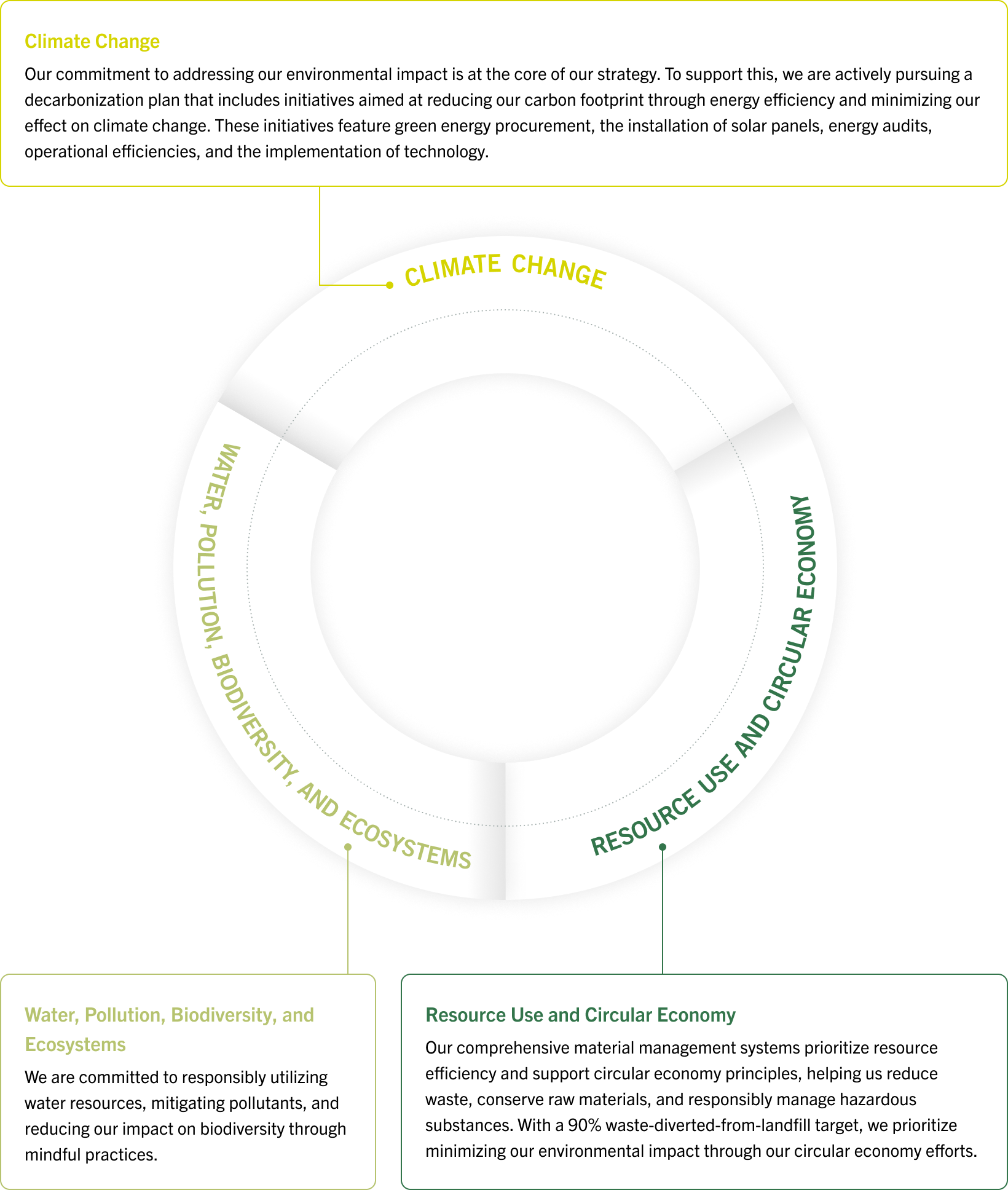Environment
ENVIRONMENTAL MANAGEMENT
Reducing the effects of our carbon emissions, driving energy efficiency, and responsibly handling waste to limit our environmental impact.
Scope 3 Targets
Purchased Goods and Services (Category 1)
Year-over-year reduction of emissions intensity
(tCO2e / US$ million)
Upstream Transportation (Category 4)
Year-over-year reduction of emissions intensity
(tCO2e / US$ million)
Waste (Category 5)
Achieve 90% waste-diverted-from landfill rate by 2030

Decarbonization
Energy
Efficiency
Climate
Risk Analysis
Pollution
Biodiversity
And Ecosystems
Water
Stewardship
Waste
Management
Resource
Use
Circular
Economy

Decarbonization
Energy
Efficiency
Climate
Risk Analysis
Pollution
Biodiversity
And Ecosystems
Water
Stewardship
Waste
Management
Resource
Use
Circular
Economy
Spotlight
Our Path to Decarbonization
TTI is committed to reducing our greenhouse gas (GHG) emissions. This commitment is grounded in our systemic best practices and standard methodologies, ensuring a robust and transparent approach to achieving our 60% reduction target for our Scope 1 and 2 GHG emissions by 2030, compared to our 2021 baseline.
Baseline vs Growth
When establishing our decarbonization goal, we began by thoroughly evaluating our 2021 GHG emissions inventory which serves as our baseline. This initial analysis provided a detailed understanding of our emissions footprint across existing facilities at that time. Through this baseline evaluation, we identified specific opportunities to reduce emissions and set a target of achieving a 60% reduction of our Scope 1 and 2 GHG emissions.
As our business has rapidly grown over the years, we have introduced new facilities and operations into our footprint. We are tracking the emissions impact of these new sites outside of our baseline to ensure that we hit the target we set in 2021.
The establishment of these new facilities is vital for the growth and sustainability of our business, enabling us to enhance customer service and operational efficiency. We have meticulously considered the carbon footprint implications of these sites as part of our comprehensive decarbonization strategy. Additionally, we are actively investigating alternative energy solutions to minimize emissions at these locations.
A key driver for the establishment of these facilities is the vertical integration of operations that were previously outsourced. This strategic move has been driven by the advancements our team has achieved in fostering product innovation. As we progress, we will concentrate on monitoring emissions from these sites and will establish a reduction target distinct from our 2021 baseline.
In 2024, we were able to reduce our absolute emissions for our baseline sites by over 4,000 tonnes compared to 2023. By comparison, our absolute emissions for our growth sites increased by about 18,000 tonnes.
Verification
We have assessed our Scope 1 and 2 emissions as a crucial element of our decarbonization strategy. Scope 1 emissions include those generated from our on-site operations and company-operated vehicles, while Scope 2 emissions arise indirectly from the electricity we purchase. We have independently verified our Scope 1 and Scope 2 emissions for 2021, our baseline year, as well as 2023 and 2024. Moving forward, we will be verifying these emissions each year.
Scope 3
While mapping our Scope 3 categories, we have prioritized managing our carbon footprint without pursuing Science Based Targets initiative validation at this time. Key factors include the potential for overstating emissions due to product durability and potential duplication of Category 11 (Use of Sold Products), as customers may already include these emissions in their Scope 3 inventory.
Additionally, the foundational calculation methodology for Categories 11 (Use of Sold Products) and 12 (End-of-Life Treatment of Sold Products) is heavily influenced by assumptions that can vary materially and/or can not be validated. For example, how long the product is used for and the method of disposal. In our updated approach, we will be focusing on reducing intensity year-over-year for the categories we have the ability to influence at this time.
We are pleased to share our Scope 3 mapping results that can be found in the Performance Metrics section of this report. We have established emission intensity as a percentage of revenue reduction targets for Category 1 (Purchased Goods & Services) and Category 4 (Upstream Transportation) on a year-over-year basis.
Our Scope 3 journey began with mapping our emissions across our value chain, prioritizing Upstream Categories 1 and 4, where we have the greatest direct influence and the potential for reductions. These categories will add to our already established waste diverted from landfill target set in 2024. This marks only the beginning of our broader commitment which we plan to develop further in the future. Since launching this initiative, we are proud of the progress made by our team and the robust processes we’ve implemented to reduce waste and optimize shipping. While our efforts remain focused on these three categories, they form the foundation of a much larger journey.
GHG Emission Reduction Roadmap
Our pathway to achieving our 60% reduction target remains on track across our short, medium, and long-term goals. In the near term, our priority is our green energy procurement strategy. In the medium-term, we are prioritizing the development of on-site solar energy, which is already underway at our China facilities. For our long-term goals, we plan to expand on-site renewable energy generation and implement energy recapture measures.
Our Scope 1 and Scope 2 absolute emissions have now peaked at our 2021 baseline sites. Following this milestone and the completion of our consolidation efforts, we anticipate steady reductions, bringing us closer to achieving our GHG emissions reduction target. Initiatives such as green energy procurement, fleet decarbonization, and on-site renewable energy projects are instrumental in driving us toward our goal. In regard to our fleet decarbonization, we planned to be further along in our EV Fleet expansion, however due to the lack of infrastructure relative to what we have anticipated, the conversion plans have been slowed but we are ready to pick back up once the opportunity arises.
Our priorities continue to emphasize sustainability through our cordless products and sustainable operations. We are committed to helping customers reduce their carbon footprint by encouraging the shift from gas-powered to battery-powered products.
Baseline Facilities GHG Emission Tracker
GHG Emission Reduction Progress (%)
Reduction
Target
Reduction
